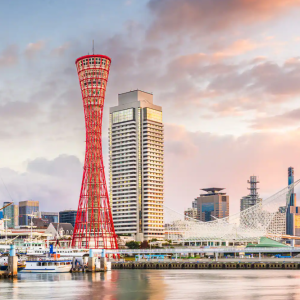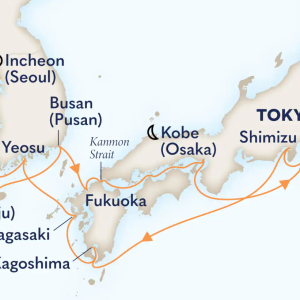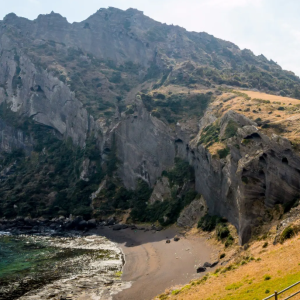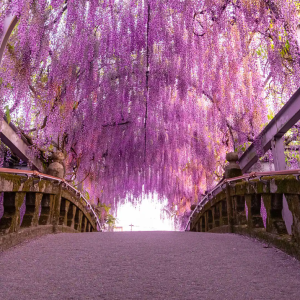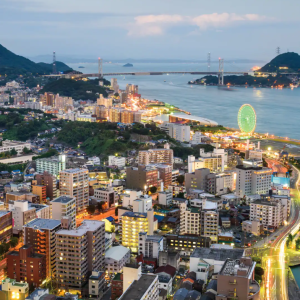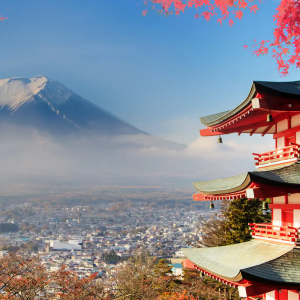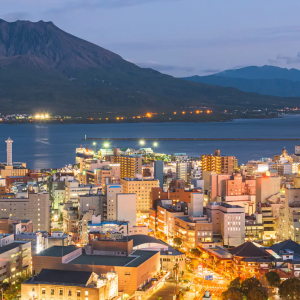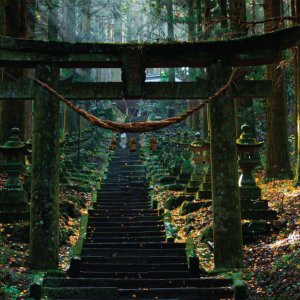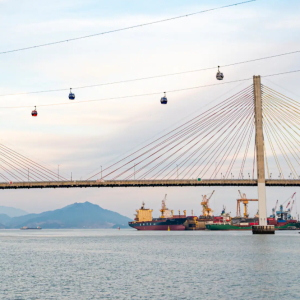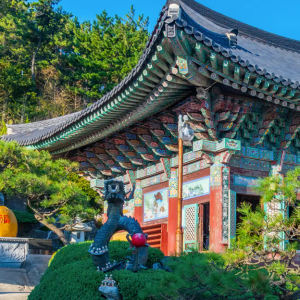Discover the coastal charm of Yeosu, South Korea, where stunning ocean views meet rich history and culture. Stroll through the vibrant Yeosu Maritime Park, visit the historic Yi Sun-sin Square, or take a cable car ride for breathtaking panoramas of the bay. Don’t miss the chance to savor fresh seafood at a local market or explore the scenic beauty of Odongdo Island, known for its lush camellia trees.
2026 AAA Member Appreciation Cruise: 15-Day Japan & South Korea Discovery
Holland America | 15 Days | Roundtrip Tokyo
AAA Member Appreciation Cruise (non-hosted)
October 4 - November 8, 2026 | From $2,514
Visit picturesque ports across Japan and South Korea, including Shimizu, a beautiful town in Mt. Fuji’s shadow. An overnight stay gives you extra time to explore Seoul.
AAA Member Benefits and Special Offers:
- Member Benefits
- $50 onboard spending credit per person
- AAA Vacations® Amenities
- $50 onboard spending credit per person
- AAA Member Appreciation Group Amenities
- $25 onboard spending credit per person
- Plate of chocolate dipped strawberries
- $20 photo credit- one per stateroom
Your Ship: Westerdam
A fascinating destination in her own right, Westerdam has won multiple Best Cruise Ship awards and features superb bar, entertainment and dining venues. During the day, rejuvenate with a spa treatment at the heavenly Greenhouse Spa & Salon®. Head to the upper decks for a friendly game of Pickleball at Sea with top-deck views. Catch a performance at the World Stage or spend your evening on the dance floor at Rolling Stone Lounge.
What's Included?
Entertainment
- Billboard Onboard
- World Stage
- Rolling Stone Lounge
Activities
- Onboard Shopping
- Fitness Center
- Casino Action
- Pickleball at Sea
- Kids Club (ages 3-17)
Bars and Lounges
- Crow's Nest
- Explorer's Lounge
- Ocean Bar
- Gallery Bar
- Sea View Bar
- Pinnacle Bar
Dining
- Pinnacle Grill
- Canaletto
- Lido Market
- Dive In (poolside grill)
- 24-Hour Room Service
- Morimoto By Sea
- The Dining Room
Day 1 (OCT 24): Tokyo, Japan
Depart @ 7:00pm
Tokyo is the largest city on earth and packed with some of the world’s best shops, museums and restaurants, big and small. While the bright neon lights and the bustle of contemporary Tokyo may be what comes to mind when you think of the city, there is another side.
Day 2 (OCT 25): Shimizu, Japan
Widely regarded as one of Japan’s most beautiful ports, Shimizu affords peerless views of Mount Fuji on a clear day and claims the scenic Miho-no-Matsubara pine forest as a backdrop (both are UNESCO World Heritage sites). The port’s temperate climate and rich culture—heavily connected to the surrounding Shizuoka region—have made it one of the country’s prime sightseeing destinations. A few of the main attractions include Kunozan Toshogu Shrine, designated a National Treasure by the Japanese government, Sumpu Castle (built in 1586) and Shizuoka Sengen Shrine, where warlord Tokugawa Ieyasu, who ushered in the Edo period, held his coming-of-age ceremony.
Day 3 (OCT 26): Day at Sea
Day 4 (OCT 27): Kagoshima, Japan
Situated at the southern tip of Japan, Kagoshima is the capital of the prefecture of the same name and famous for its dramatic views of Sakurajima, an active volcano that smolders across the bay. One of the most popular activities is taking a ferry to Sakurajima and hiking on the 100-year-old lava flow that is now a grassy peninsula. Kagoshima, however, offers much more than the volcano’s almost overwhelming beauty. The food scene provides opportunities to experience the area’s rich culinary culture and features dishes using locally caught fish and regional specialties, like satsuma a’ge (deep-fried fish cake) and shōchū, a traditional beverage made at more than 100 distilleries in Kagoshima alone.
Day 5 (OCT 28): Nagasaki, Japan
Situated in the northwest of Kyushu, the third-largest island in Japan, Nagasaki is one of the country’s most cosmopolitan port cities, with a decent tourism infrastructure, a fascinating past that stretches back to the early 7th century and a picturesque harbor that’s been an active port since the 16th century. Home to around 500,000 residents, the city is a buzzy yet relaxed place with abundant services, shops and restaurants as well as several cultural and historic attractions that are easily explored on foot and via public transportation. Check out the Nagasaki Peace Park and Atomic Bomb Museum, which outline the horrific bombing of the city during World War II while making a poignant pledge for world peace. Foodies will enjoy the wide variety of tastes to be found in Chinatown and the Shianbashi Gourmet Street.
Day 6 (OCT 29): Yeosu, South Korea
Day 7 (OCT 30): Day at Sea
Days 8-9 (OCT 31-NOV 1): Incheon (Seoul), Korea
Once upon a time, Incheon was a quiet seaside village, pretty typical for Korea. The men went fishing, the women made kimchi. There were maybe a couple thousand people altogether in the region. And then it got caught in the middle of a war. Incheon is where, late in 1950, the U.S. Marines landed, marking the beginning of the end of the Korean War, a war that ultimately claimed more than 40,000 American soldiers’ lives and an undetermined number of Koreans. After the fighting, when Incheon had a chance to dig itself out from the mud and shrapnel, it became part of the Korean economic miracle, the country’s first official free-enterprise zone. With its perfect natural port, flat landscape and 3 million residents, it’s become as much a part of the Seoul megalopolis now as it is a place of its own.
Day 10 (NOV 2): Jeju City, South Korea
Jeju, formerly Cheju, may not be familiar to most Americans, but for Korean travelers the country’s largest island and home to one of 12 UNESCO World Heritage Sites is a popular destination. The island is roughly the size of Maui and has much in common with the Hawaiian islands. Like them, it is a volcanic island—it first emerged from the sea some two million years ago and the volcano Hallasan, which reaches a height of 1,950 meters, is the tallest peak in South Korea. It also shares the mild subtropical climate of Hawaii—even in winter, temperatures rarely drop below freezing—and offers a similar broad range of activities whether in the warm ocean water or exploring the island’s interior on well-marked and maintained trails.
Day 11 (NOV 3): Busan, South Korea
Busan combines a vibrant, big-city atmosphere with a famously laid-back attitude and subtropical landscapes. Often described as the "San Francisco of Korea," thanks mainly to its hilly terrain and close-knit neighborhoods, it offers visitors a little of everything: fashionable boutiques, dynamic culture and buzzy nightlife, as well as sandy beaches, hot springs and nearby mountains crossed with hiking trails and dotted with temples. Cultural highlights include the Gamcheon Cultural Village; the spectacular Haedong Yonggungsa Temple, built into the side of a cliff; and Art Street in Sinchang-dong, which hosts art competitions, exhibitions and cultural events such as the annual Busan International Film Festival.
Day 12 (NOV 4): Fukuoka, Japan
Fukuoka, Kyushu's largest city, was once two separate entities: Fukuoka in the west and the merchant area of Hakata to the east. Joined together in 1889, the contemporary city—population 1.5 million—has a lively, modern atmosphere, an array of impressive architecture by international starchitects, including Rem Koolhaas, César Pelli, Emilio Ambasz and Aldo Rossi, and a number of cultural attractions and museums such as the Fukuoka Asian Art Museum. Modern developments like Canal City—a mixed-use complex designed by American Jon Jerde that contains hotels, cinemas, restaurants and shops—lend the city space a futuristic air, as does the striking 768-foot Fukuoka Tower, which is covered in mirrored glass and has an observation deck.
Day 13 (NOV 5): Scenic Cruising Kanmon Strait
The Kanmon Strait is a narrow channel of water that separates two of Japan's main islands, Honshu and Kyushu. The channel has long been important to maritime transportation and cargo ships, as it connects the Sea of Japan and the Inland Sea.
Day 14 (NOV 6): Kobe, Japan
A stop in Kobe, Japan, offers a perfect blend of tradition and modernity, set against a stunning harbor backdrop. Explore the historic Kitano district with its charming European-style homes, savor world-famous Kobe beef, or take in breathtaking city views from the top of Mount Rokko. Don’t miss the chance to visit the serene Ikuta Shrine or unwind in the nearby Arima Onsen, one of Japan’s oldest hot spring resorts.
Day 15 (NOV 7): Day at Sea
Day 16 (NOV 8): Tokyo, Japan
Arrive @ 8:00am
All pricing and offers for accommodations and other non-air travel are per person, based on double occupancy, capacity controlled and subject to availability and change without notice. Pricing does not include taxes, fees, fuel surcharges, gratuities, resort fees, or airfare unless otherwise noted and is valid on new bookings only. Prices, fees, and other restrictions are subject to supplier policies. All offers, including but not limited to, bonus amenities, upgrades, prices, and group benefits are based on select dates, resorts, room categories, and/or fare codes. Specialty pricing may require proper identification. Cancellation penalties, blackout dates, and other restrictions may apply. When traveling outside the United States a valid passport is required. It is the sole responsibility of the passenger to have the proper documentation and identification required by the United States and other governments at the time of travel. When passports are required, it must be valid for a minimum of six months past your date of return. AAA strongly recommends the purchase of Travel Insurance. Usage of a credit card for travel arrangements may provide additional protection, please consult your credit card policies. Under certain circumstances the package price may be subject to supplemental price increases imposed by the supplier. Price increases include, but are not limited to fuel surcharges, taxes or fluctuations in foreign exchange markets that may be imposed after the date of purchase. Air-inclusive prices do not include government imposed taxes and fees, including but not limited to a September 11th Security Fee, U.S. or international government imposed taxes and fees, Federal Excise Fees, among others. Some carriers charge additional fees for checked bags, fuel surcharge, meals, etc. Please check the carriers website for details. Air-inclusive pricing is based on select departure cities. Prices from other cities may vary. AAA Oregon/Idaho acts solely as a sales agent for travel suppliers and is not responsible for the actions or inactions of such suppliers. We monitor all of the information presented on our website; however, we do not assume responsibility for any errors or omissions in the content of the offers displayed. Review full Travel Disclosure and Consent at time of booking.
 Click Here to View Your Vacation
Click Here to View Your Vacation
